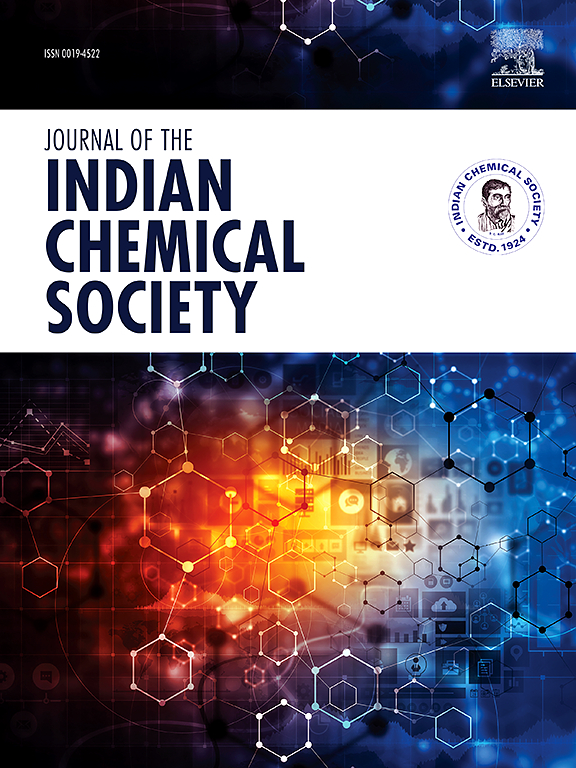Estimation of activity coefficient of aqueous ionic liquids using a machine learning method: The artificial neural network coupled with group contribution approach
IF 3.2
4区 化学
Q2 CHEMISTRY, MULTIDISCIPLINARY
引用次数: 0
Abstract
In this study a Machine Learning (ML) approach based on the artificial neural network (ANN) coupled with Group Contribution (GC) has been developed to estimate the mean ionic activity coefficient (MIAC) of aqueous quaternary ammonium salts (QASs). ML is a subset of Artificial intelligence (AI) that focuses on the development of algorithms that allow computers to learn from and make decisions based on data. Prediction of the activity coefficient of QAS using a thermodynamic model such as the equation of state (EoS) or empirical models at high concentrations is difficult. Therefore, the ML methods are a good alternative to estimate the MIAC of the new-designed QASs. In this work, 31 aqueous QASs and 880 data points have been collected to develop the ANN network. The collected data have been divided into three subsets; 620 training, 130 testing, and 130 validation data points. The critical temperature (Tc), critical volume (Vc), acentric factor (ω), molality, and molecular weight of QASs have been considered as input layer. The Tc, Vc, and ω have been estimated using the group contribution (GC) methods. Therefore, the input variables can be estimated using the molecular structure of ionic liquids. The training correlating coefficient (R2), and the training performance (MSE) have been obtained 0.9994 and 0.0027, respectively. The results of the ANN + GC method have been compared to the Pitzer, e-NRTL, and ePC-SAFT models. The average ARD value of the ANN + GC model is lower than the aforementioned models. This work shows that the ANN + GC approach can be utilized as a robust model for the estimation of the activity coefficient of aqueous ionic liquids up to high concentrations. It must be noted that, the ANN + GC model can be used to predict the MIAC of new-designed QASs in the absence of experimental data.

基于机器学习方法的水溶液离子液体活度系数估计:人工神经网络与群体贡献法相结合
本文提出了一种基于人工神经网络(ANN)和基团贡献(GC)的机器学习(ML)方法来估计季铵盐(QASs)的平均离子活度系数(MIAC)。ML是人工智能(AI)的一个子集,专注于开发算法,使计算机能够从数据中学习并根据数据做出决策。在高浓度情况下,利用热力学模型如状态方程(EoS)或经验模型来预测QAS的活度系数是困难的。因此,ML方法是估计新设计的QASs的MIAC的一个很好的替代方法。在这项工作中,我们收集了31个水溶液QASs和880个数据点来开发人工神经网络。收集到的数据被分为三个子集;620个训练,130个测试和130个验证数据点。将临界温度(Tc)、临界体积(Vc)、离心因数(ω)、质量摩尔浓度和分子量作为输入层。使用群体贡献(GC)方法估计了Tc, Vc和ω。因此,可以利用离子液体的分子结构来估计输入变量。训练相关系数(R2)和训练绩效(MSE)分别为0.9994和0.0027。ANN + GC方法的结果已与Pitzer, e-NRTL和ePC-SAFT模型进行了比较。ANN + GC模型的平均ARD值低于上述模型。这项工作表明,ANN + GC方法可以作为估计高浓度水溶液离子液体活度系数的稳健模型。必须注意的是,在没有实验数据的情况下,ANN + GC模型可以用来预测新设计的QASs的MIAC。
本文章由计算机程序翻译,如有差异,请以英文原文为准。
求助全文
约1分钟内获得全文
求助全文
来源期刊
CiteScore
3.50
自引率
7.70%
发文量
492
审稿时长
3-8 weeks
期刊介绍:
The Journal of the Indian Chemical Society publishes original, fundamental, theorical, experimental research work of highest quality in all areas of chemistry, biochemistry, medicinal chemistry, electrochemistry, agrochemistry, chemical engineering and technology, food chemistry, environmental chemistry, etc.

 求助内容:
求助内容: 应助结果提醒方式:
应助结果提醒方式:


